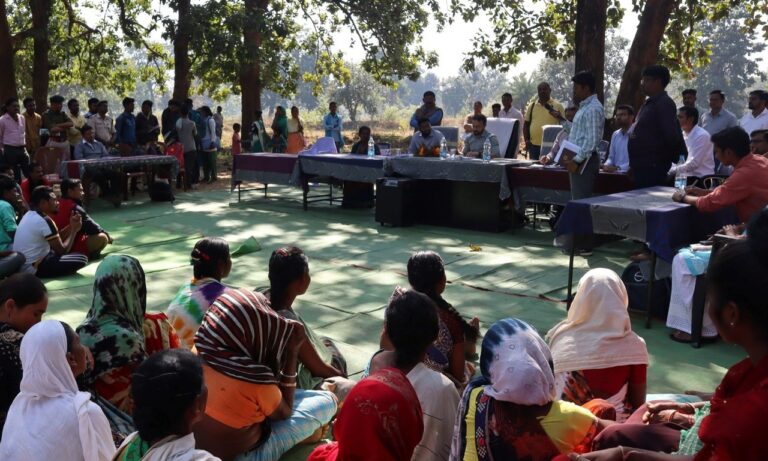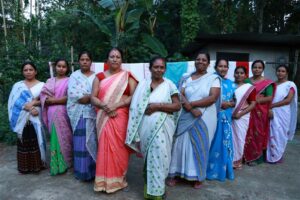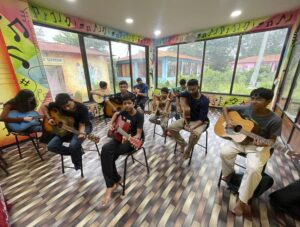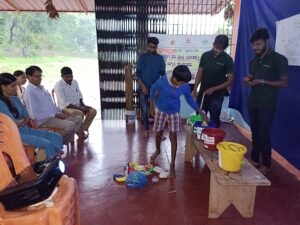The District administration of Dantewada under the leadership of the District Collector Vinit Nandawar
has valiantly reached out to remote villages through “Nidaan Shivir” (diagnostic camps). Collector himself
a local role model, who is an inspiration for many in the Left-Wing Extremism affected region of Bastar,
has been fearless in his approach of putting an ear to the ground. District administration under his
supervision, worked out a strategy to resolve the problems and demands of villagers. Under this
innovative and determined framework, the administration has reached out to people in villages
considered to be extremely sensitive.
Dantewada is a tribal-dominated district with a 76.9% Scheduled Tribe (ST) population of Madia, Muriah,
Dhurwa, Halba, Bhatra, and Gond. Also, Dantewada is immensely affected by the Left Wing Extremist
(LWE) activities. Due to remoteness and extremism, Dantewada consistently had been performing badly
on the development indicators. The literacy rate in the district is 42% (Census 2011), nearly 50% of
children aged 0-6 years are malnourished and 60% of women in the age group of 15-60 are anemic (NFHSV). The livelihood in the district is mostly farm and forest oriented. The agriculture is rainfed which
increases community dependency on forests. Simple-minded and innocent tribal people of the district
have not yet developed competitive business acumen.
Taking into account factors such as unsatisfactory performance on development indicators, simplicity in
the lifestyle of people, and the sense of perceived distance from the administration, the community has
unfortunately been greatly affected. They have a poor understanding of government policies and
schemes. The threat of Left-Wing extremism in the past decades has also contributed to the limited
government outreach to the last mile. Despite the efforts of many administrators in the past, the existing
systems were not able to effectively facilitate the community’s awareness and access to the benefits of
government policies.
The revenue records needed updation in numerous villages. In Dantewada, a dominantly tribal
inhabitation, land conflicts in terms of mutation, removing the names of the deceased, partition, etc. are
common. People are also not very well informed about the benefits that can be obtained with the caste
certificate, which prevented students from using welfare assistance like scholarships, rebates in fees, and
reservations in educational institutes and employment.
In addition to that, the slow process of getting assistance, and the sequences between departments made
it difficult for people to trust the paperwork and procedure. These situations deter people from acquiring
benefits. To bridge these gaps so created, Nidaan Shivir was implemented.
With intense determination, the administration implemented Nidaan Shivir (Diagnosis camps) in remote
villages across the district. As a part of proactive governance, there needed to be key preparations done
before the camp by the District collector. Prerequisites were that village must be Rajswa Vivadmukta
(Revenue conflict-ridden) and caste certificates of all the school-going be prepared. Additionally, all the
grievances of villagers be collected, enumerated and proactively the work must begin to address them.
It was strategized that the field staff of departments will actively work and reach out to people to resolve
all the matters of contention. A date would be decided for Nidaan Shivir of villages in a cluster, where all
the district officials would be present. A department-wise review of performance would be done by the
District collector in the presence of the community along with community feedback. It was also decided
that strict actions would be taken against the staff whose work will not be up to the mark.
The Revenue Department was instructed to resolve all issues in the villages related to revenue. Field staff
in the administration were to reach out to the beneficiariesin villages. The revenue office needs to update
all land records under which mutation, partition, and demarcation have been done and each khata of the
village has been cross-checked deliberately by the way of B1 vachan. Field staff were directed to
emphasize the need, rationale, and importance of B1 vachan, so that, not a single revenue record is left
to update.
A similar strategy was developed for making Caste certificates. District administration started the process
for issuance of the caste certificates with the education department as the nodal for application
submission. With the intention that the students must not lose out on the benefits of Caste certificates,
the schools were assigned the responsibility to help fill up the application forms for their students by
putting up all the necessary documents like Aadhar cards and report cards and submitting the application
in the Tehsil Office.
The due process of issuing the caste certificate was to be done by the revenue office. Sub-Divisional
Magistrate’s (SDM) office was directed to compulsorily laminate the certificate before delivering it to the
beneficiary at their doorstep. The idea behind laminating the certificate was to enhance the longevity of
the Caste certificate even in the villages with Kuccha houses where certificates would get damp.
The entitlement demands needed to be put into consideration too. The social welfare department was
directed to provide pensions to old age people, widows, and persons with disabilities. The health
department was to ensure that the medicine box of Mitanins must have all the necessary medicines. The
food department was directed to ensure the quality and quantity of food grains provided to the
beneficiaries in the PDS shops.
Following these strategies, field staff in the administration reached out to the beneficiaries in villages
before Nidaan shivir was conducted. B1 vachan began at an unprecedented pace. The education
department coordinated with the Tehsil office to issue caste certificates proactively. Other line
departments also started completing their field tasks. On the decided dates, District Collector reviewed
the performances of departments in the villages and asked for community feedback.
With such a pragmatic initiative of District administration, Dantewada achieved a milestone in the year
2022-23, delivering 20,120 Caste certificates within a year. 50 villages in the whole district were declared
Rajswa Vivad-Mukt village. A total of 1369 cases were resolved in these villages related to land conflicts.
The district administration has now set the target of issuance at 12,135 caste certificates for the FY 2023-
24. A target of 85 more villages to be made rajswa vivad-mukt in the year 2023-24 has been set.
The initiative of Nidaan Shivir has seen unprecedented community participation in government camps.
The credit for the success must be given to the district collector for his active involvement throughout. In
the most inaccessible villages where the roads were not good enough for his car, District Collector even
reached out to the villagers on the motorbike with his team. Such acts of goodness helped build trust in
the community. Seeing his car pass through, villagers would often stop the vehicle to treat him cordially.
Nidan Shivir (Diagnostic camps) truly emerged as a platform of grievance redressal for the villagers,
bridging the gap between Government and the community. With every voice being heard at the
grassroots, this remarkable strategy actualized proactive governance in Dantewada.





